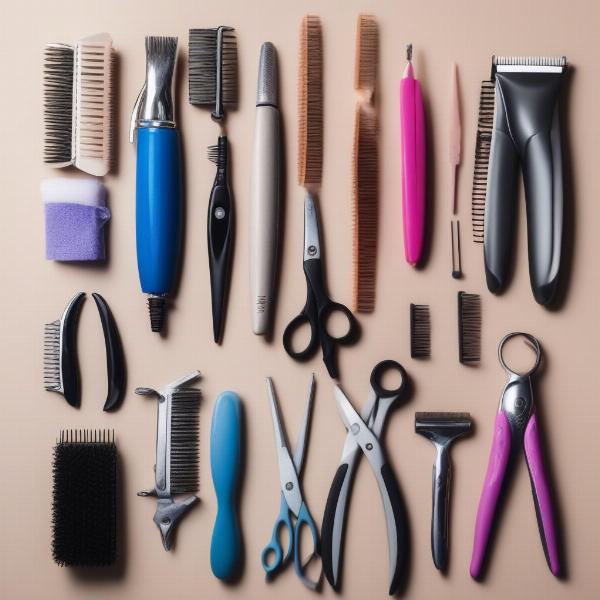Dog grooming is an essential aspect of responsible pet ownership, whether you live in the bustling city or the serene countryside. It contributes significantly to your dog’s overall health, comfort, and well-being. While the core principles of grooming remain the same regardless of location, certain considerations and challenges can arise depending on your environment. This article will delve into the nuances of dog grooming in town and country, providing you with practical tips and advice to ensure your furry friend looks and feels their best, no matter where you call home.
Urban Dog Grooming: Navigating the Cityscape
City life presents unique challenges for dog owners, and grooming is no exception. Limited space, concrete pavements, and exposure to pollutants require a tailored approach to keeping your canine companion clean and healthy.
Frequent Bathing: City dogs often pick up more dirt and grime from city streets. Regular baths, using a gentle dog shampoo, are crucial for maintaining hygiene and preventing skin irritations.
Paw Care: Hot pavements and rough surfaces can take a toll on your dog’s paws. Regular paw cleaning and moisturizing are essential, especially during summer. Consider using paw balm to protect their pads from harsh elements.
Coat Management: Shorter coats are often preferred for city dogs, as they require less maintenance and are less likely to trap dirt and debris. Regular brushing is still necessary to prevent matting and remove loose fur.
Professional Grooming Services: City dwellers often benefit from utilizing professional grooming services. These services offer convenience and expertise, especially for breeds requiring specialized grooming techniques.
Rural Dog Grooming: Embracing the Great Outdoors
Country living offers dogs the freedom to explore nature, but it also exposes them to different grooming challenges. From muddy fields to burrs and ticks, rural dogs require specific grooming routines.
Dealing with Mud and Debris: Regular brushing is crucial for removing mud, burrs, and other debris that accumulate in your dog’s coat during outdoor adventures. Invest in a sturdy brush and de-matting tools.
Parasite Prevention: Ticks and fleas are more prevalent in rural areas. Regularly check your dog for parasites and use preventative treatments as recommended by your veterinarian.
Seasonal Coat Changes: Dogs living in areas with distinct seasons may experience significant coat changes. Regular brushing during shedding seasons helps manage loose fur and prevents matting.
Protecting from the Elements: Extreme weather conditions can impact your dog’s coat and skin. Consider using dog-specific sunscreen in summer and protective coats or boots in winter.
Choosing the Right Grooming Tools
Regardless of location, using the right grooming tools is essential for effective and comfortable grooming sessions. Here’s a quick guide:
- Slicker Brush: Ideal for removing loose hair and mats.
- Bristle Brush: Suitable for short-haired breeds to distribute natural oils and add shine.
- De-matting Comb: Specifically designed for removing tough mats and tangles.
- Nail Clippers: Essential for maintaining healthy nail length.
- Dog Shampoo and Conditioner: Choose gentle, pH-balanced products formulated for dogs.
 Dog Grooming Tools: An assortment of dog grooming tools.
Dog Grooming Tools: An assortment of dog grooming tools.
Conclusion
Dog grooming is a vital part of responsible pet ownership, whether you live in the city or the country. By adapting your grooming routine to your specific environment and utilizing the right tools and techniques, you can ensure your canine companion stays healthy, happy, and looking their best. Remember to consult with your veterinarian for personalized advice and recommendations based on your dog’s breed, age, and health condition.
FAQ
- How often should I bathe my dog? It depends on your dog’s breed, lifestyle, and coat type. Generally, bathing every 4-8 weeks is sufficient.
- What’s the best way to remove mats from my dog’s fur? Use a de-matting comb or seek professional grooming assistance for stubborn mats.
- How can I protect my dog’s paws from hot pavement? Use paw balm or consider walking your dog during cooler parts of the day.
- What are the signs of a tick infestation? Excessive scratching, redness, and small bumps on the skin are common signs.
- How often should I trim my dog’s nails? Trim your dog’s nails as needed, typically every 2-4 weeks.
ILM Dog is your trusted resource for expert advice and practical tips on all aspects of dog care, from breed selection and health to training and nutrition. We offer a wealth of information to empower dog owners worldwide to provide the best possible care for their furry companions. Whether you’re a seasoned dog owner or just starting your journey, we’re here to help. For personalized guidance, please contact us at [email protected] or +44 20-3965-8624. Visit ILM Dog for more valuable insights and resources.